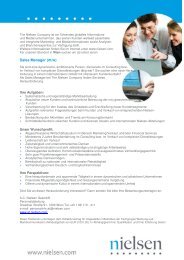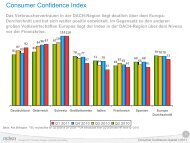Create successful ePaper yourself
Turn your PDF publications into a flip-book with our unique Google optimized e-Paper software.
the potential demand. The result is improved operational<br />
execution, reduced out-of-stocks, fewer overstocks,<br />
enhanced promotion performance and better inventory<br />
management.<br />
Step 1: Consumer profiling<br />
The consumer should be the first and last consideration of<br />
any consumer-centric initiative and the C.O.D.E. approach<br />
is no different. Products do not buy themselves, just as<br />
shelves do not mysteriously empty by themselves. While<br />
price reductions, competition, brand equity, slotting and the<br />
like all influence purchasing, the common denominator is<br />
the consumer.<br />
It is only appropriate then, that the C.O.D.E. approach<br />
starts with consumer profiling. There are various types<br />
of consumer profiling information available, from panel<br />
purchase behavior to attitude and usage studies to focus<br />
groups. Traditionally, point-of-sale (POS) data has been<br />
utilized to tell us “what happened” but not who drove it.<br />
Through consumer regression profiling, it becomes<br />
possible to create a sales-weighted store profile by<br />
estimating future consumer demand for products based<br />
on historical sales data.<br />
ACNielsen Homescan & Spectra recommends utilizing<br />
panel data to determine category and brand breaks, and<br />
Opportunity Finder solutions to “consumerize” product<br />
movement data, enabling retail-specific and item-specific<br />
store profiles. This approach yields granular analyses down<br />
to the SKU level. The analyses become retail-specific, based<br />
on the retailer’s own data, which adds power to the recommendations.<br />
Regardless of source, consumer profiles can be<br />
used individually or in combination to formulate step one<br />
of Cracking the Retail C.O.D.E.<br />
Step 2: Opportunity gapping<br />
Are you leaving sales on the table? If so, how much? What<br />
“Opportunity gapping provides<br />
an indication of how much the<br />
category could grow tomorrow if<br />
I could fully execute, instead of only trying to<br />
capture my fair share of yesterday’s volume.”<br />
needs to change to convert potential and lost sales into reg-<br />
–Michael Himmelfarb, VP of Marketing<br />
ACNielsen Homescan & Spectra<br />
ister rings? Opportunity gapping quantifies the opportunity<br />
cost to each store for missing the mark two ways—either<br />
with consumers or on the execution level. While fair share<br />
gapping is a common practice to determine if a brand or<br />
product is getting its expected share of the account or market<br />
pie, what if you could estimate how big the slice would be?<br />
Consumer profiling is the first step in executing the<br />
C.O.D.E. approach, but without action it just becomes<br />
“nice to know.” In order to quantify opportunity, matching<br />
the consumer profile to the known shoppers of an account<br />
is critical. The degree of sophistication can vary from profiling<br />
your consumer and identifying a common trait within<br />
a retailer (i.e., matching high income consumers to a high<br />
income account like Whole Foods), to scoring an account<br />
at the store level based on the most volume-predictive<br />
consumers, also known as the Spectra Demand Index.<br />
In essence, while Step One determines your consumer’s<br />
fingerprint, Step Two matches it to an account’s fingerprint—or<br />
even better, an account’s store-level fingerprints.<br />
Now you have a basic roadmap for tomorrow’s volume.<br />
44 Fall/Winter 2006











